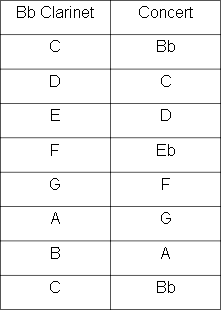Transposition
What is transposition and why do we have it?
There are many different musical instruments that are available and they come in many shapes and sizes. Some are concert pitch instruments which mean that when they play the note C, it will sound like a C and some are transposing instruments which mean that when they play a C, it will sound like a different note. Some examples of concert pitch instruments are; Piano, Violin, Guitar, Descant Recorder, Flute and Oboe. Transposing instruments include; Clarinet, Trumpet, French Horn and saxophone etc. There are many more examples of instruments that are concert pitch and transposing.
When a clarinet plays a C it can sound like an Eb, Bb an A or even a C (because there is also a concert pitch clarinet). Now imagine them all playing the same piece of music from the same sheet. A similar situation to this actually happened around 150 years ago in front of Queen Victoria and as you might imagine, it didn’t sound pretty and was very embarrassing for all concerned. See History of the Royal Military School of Music; http://www.army.mod.uk/music/23292.aspx(see the 4th paragraph)
In the theory exams you will be faced with a choice of two types of questions;
1 Transpose a piece with key signature
2 Transpose a piece without key signature
To tackle either you must understand what the question is asking. The wording in the exam can be confusing so do check (and check again) whether the answer is to end up written for the transposing instrument or in concert pitch,
If the music is for Bb Clarinet then whenever the clarinet plays a note C, it really sounds like a Bb in concert pitch. The interval between these notes is a Major 2nd so whatever you do the answer must be a Major 2nd away from the question.
This can be the same for Eb instruments as well. If the Eb instrument plays a C then the concert pitch mote is Eb. The interval is a minor 3rd away. An F pitched instrument will be a 4th away and so on…
Let’s deal with the Bb pitched instruments.
We’ll pretend the question is in concert pitch and the key of this music is C Major and the question asks for you to transpose for the clarinet to play at the correct pitch with a key signature. The first three notes of the music for this exercise are C, Db & E.
To do this draw a table and put the scale of C Major down one side under Bb Clt and on the other side concert;
You will notice that I have filled in the notes under concert but if you look closely, you will see that when the clarinet plays a C, the concert note is Bb. When the clarinet plays D, the concert is C and so on... You may have noticed that the scale on the right is Bb Major. This is because the transposition is a Major 2nd down from the Bb pitched clarinet so when the clarinet plays C major it is really sounding Bb Major.
Now to the question...
The key signature is C major concert so to transpose the key signature, look for the C note in the table under concert and next to this is the clarinet equivalent. This is D so the key signature required in the answer is D major (two sharps-
If your question is dealing with Eb pitched instruments or F pitched instruments or any other pitches, remember to use the corresponding scale. When an Eb pitched instrument plays C the concert note is Eb so you will write the scale of Eb major and so on.
If the question has a key signature and you are not required to use a key signature in the answer, don’t forget that the key signature notes may require accidentals next to the notes. You will not need to transpose the key like you did in the previous example.
Tip! To save time, if the question and answer require a key signature the only notes that require an accidental are the notes with accidentals in the question.




